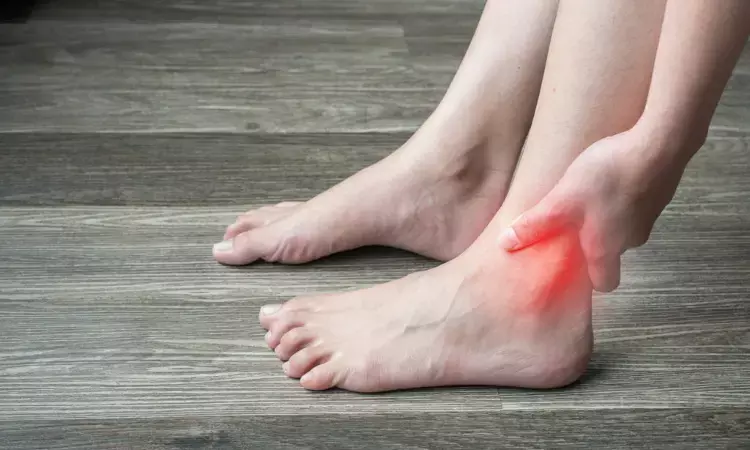- Home
- Medical news & Guidelines
- Anesthesiology
- Cardiology and CTVS
- Critical Care
- Dentistry
- Dermatology
- Diabetes and Endocrinology
- ENT
- Gastroenterology
- Medicine
- Nephrology
- Neurology
- Obstretics-Gynaecology
- Oncology
- Ophthalmology
- Orthopaedics
- Pediatrics-Neonatology
- Psychiatry
- Pulmonology
- Radiology
- Surgery
- Urology
- Laboratory Medicine
- Diet
- Nursing
- Paramedical
- Physiotherapy
- Health news
- Fact Check
- Bone Health Fact Check
- Brain Health Fact Check
- Cancer Related Fact Check
- Child Care Fact Check
- Dental and oral health fact check
- Diabetes and metabolic health fact check
- Diet and Nutrition Fact Check
- Eye and ENT Care Fact Check
- Fitness fact check
- Gut health fact check
- Heart health fact check
- Kidney health fact check
- Medical education fact check
- Men's health fact check
- Respiratory fact check
- Skin and hair care fact check
- Vaccine and Immunization fact check
- Women's health fact check
- AYUSH
- State News
- Andaman and Nicobar Islands
- Andhra Pradesh
- Arunachal Pradesh
- Assam
- Bihar
- Chandigarh
- Chattisgarh
- Dadra and Nagar Haveli
- Daman and Diu
- Delhi
- Goa
- Gujarat
- Haryana
- Himachal Pradesh
- Jammu & Kashmir
- Jharkhand
- Karnataka
- Kerala
- Ladakh
- Lakshadweep
- Madhya Pradesh
- Maharashtra
- Manipur
- Meghalaya
- Mizoram
- Nagaland
- Odisha
- Puducherry
- Punjab
- Rajasthan
- Sikkim
- Tamil Nadu
- Telangana
- Tripura
- Uttar Pradesh
- Uttrakhand
- West Bengal
- Medical Education
- Industry
Early weight-bearing effective for recovery and cost in ankle fracture patients: Study

A new study published in The Lancet journal found an early weight-bearing method to be both extremely likely to be cost-effective and clinically non-inferior to the present standard of treatment (delayed weight-bearing).
The patients with fractured ankles are often told not to walk for 6 weeks following surgery (delayed weight-bearing). Early weight-bearing (walking) two weeks post-surgery may be a safer and better rehabilitation approach. In order to examine the clinical and financial efficacy of an early weight-bearing method vs a delayed weight-bearing strategy, Christopher Patrick Bretherton and colleagues undertook this study.
This pragmatic, randomised, multicenter, non-inferiority trial included 561 participants (over 18 years) who underwent acute surgery in 23 NHS hospitals in the UK for an unstable ankle fracture. The participants were randomly assigned to an early weight-bearing rehabilitation strategy (n = 281) or a delayed weight-bearing rehabilitation strategy (n = 280). Excluded patients were those receiving treatment for a hindfoot nail, those without protective ankle feeling (such as peripheral neuropathy), those incapable of giving informed permission, and those unable to follow study protocols. The therapy was not concealed from either the subjects or the doctors. The Olerud and Molander Ankle Score (OMAS), which measures ankle function in the per-protocol population 4 months after randomization, was the main outcome. The intention-to-treat population underwent superiority testing in the event of non-inferiority, and the pre-specified non-inferiority OMAS margin was –6 points.
Of the 561 individuals, 480 (86%) had primary outcome data collected with the hiring period running between January 13, 2020 and October 29, 2021. 4 months post-randomization, the mean OMAS score of early weight-bearing group was 65·9, while the delayed weight-bearing group's was 61·2. The adjusted mean difference was 4·47, favoring the early weight-bearing group. One or more problems were experienced by 46 (16%) individuals in the early weight-bearing group and 39 (14%) participants in the delayed weight-bearing group.
In the early and delayed weight-bearing groups, the mean costs to the NHS and personal social services were £725 and £785, respectively. Also, more than 80% of people believed that early weight-bearing was cost-effective. Overall, this study found that an early weight-bearing technique is not inferior to delayed weight-bearing following ankle fracture repair and is very likely to be cost-effective.
Reference:
Bretherton, C. P., Achten, J., Jogarah, V., Petrou, S., Peckham, N., Achana, F., Appelbe, D., Kearney, R., Claireux, H., Bell, P., Griffin, X. L., McAndrew, A., Jacobs, N., Forder, J., Hester, T., Cross, C., Bateman, T., Kieffer, W., Barton, T., … White, T. (2024). Early versus delayed weight-bearing following operatively treated ankle fracture (WAX): a non-inferiority, multicentre, randomised controlled trial. In The Lancet (Vol. 403, Issue 10446, pp. 2787–2797). Elsevier BV. https://doi.org/10.1016/s0140-6736(24)00710-4
Neuroscience Masters graduate
Jacinthlyn Sylvia, a Neuroscience Master's graduate from Chennai has worked extensively in deciphering the neurobiology of cognition and motor control in aging. She also has spread-out exposure to Neurosurgery from her Bachelor’s. She is currently involved in active Neuro-Oncology research. She is an upcoming neuroscientist with a fiery passion for writing. Her news cover at Medical Dialogues feature recent discoveries and updates from the healthcare and biomedical research fields. She can be reached at editorial@medicaldialogues.in
Dr Kamal Kant Kohli-MBBS, DTCD- a chest specialist with more than 30 years of practice and a flair for writing clinical articles, Dr Kamal Kant Kohli joined Medical Dialogues as a Chief Editor of Medical News. Besides writing articles, as an editor, he proofreads and verifies all the medical content published on Medical Dialogues including those coming from journals, studies,medical conferences,guidelines etc. Email: drkohli@medicaldialogues.in. Contact no. 011-43720751


